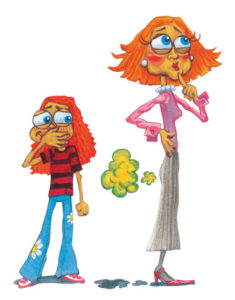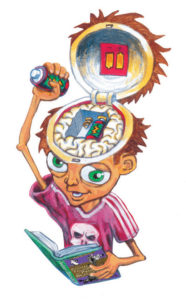If you spent much time in the world of publishing, you might at some point start to wonder if the people who work in children’s publishing had an inferiority complex. Or if they didn’t, they must surely be on their way to developing one.
The main reason for this, in my opinion, is the perception that writing for children is the easy option. And it is fair to say, that children’s books are, in general, shorter, use simpler language, involve simpler scenarios and simpler plots and often feature less nuanced characters than books aimed at grown-up audiences.
When referring to these different audiences, I have to choose my words carefully here, as ‘adult books’ can imply something entirely different and actually, a lot of adults read children’s and especially YA books. In fact, in some cases, more adults are reading young adult fiction than the young adults themselves.
But the point about our stories having to be simpler to understand is true enough. There is also a lot of formulaic writing in children’s publishing. And though there’s plenty of it in non-children’s publishing too, it’s assumed to be worse in children’s books.  Even the word ‘childish’ – to be like a child – is a negative term, referring to the things children like or the ways that they behave, as if they are automatically inferior to adults. Which begs the question, where did all these sophisticated adults come from and at what stage in their development did they become separate from, and superior to, their younger selves?
Even the word ‘childish’ – to be like a child – is a negative term, referring to the things children like or the ways that they behave, as if they are automatically inferior to adults. Which begs the question, where did all these sophisticated adults come from and at what stage in their development did they become separate from, and superior to, their younger selves?
I don’t want to make any particular points about the quality of the different kinds of writing here, except to say, from over ten years experience of making a living as a writer of fiction, it’s harder to write well, simply and clearly, than to write in an obtuse and complicated way. After all, it’s not about the beauty of the language you use, or the complexity of the emotion you wish to convey, but whether your thoughts are received and understood by the reader. And the more complex or nuanced the idea, the more inventive you have to be to get it across in a focussed, understandable and emotionally engaging way.
It is communication and, in the end, it’s the effect on your reader that counts.
Now, there are people who might point out that older readers are more sophisticated, more informed, better educated, that they have years of literary reference, a more worldly perspective, that they have seen more, experienced more, have higher expectations and will recognize work that is unoriginal or clumsy or superficial. Which makes it more challenging to write for adults. And they’d be right about most of that stuff, but if there’s one thing I’ve learned that sets a children’s writer apart from others – at least one who wants to sell enough to make a living from it for any length of time – it is that they must have an awareness of, and curiosity about, a reader who by definition, is not like them.
So . . . writing for kids. The easy option, yeah? Let’s have a look at that.
You might be the most significant writer of the century, with a timeless story to tell, and profound lessons to teach the new generation, but if you can’t get them to turn the pages, it won’t count for anything. People have to put an effort into reading text. Unlike television, film or even audio-books, text requires active audience participation.  A bit like bringing someone to hear an orchestra play . . . and handing them an instrument. One cannot read passively. It takes effort. It wears you out.
A bit like bringing someone to hear an orchestra play . . . and handing them an instrument. One cannot read passively. It takes effort. It wears you out.
Now, imagine your reader isn’t very good at reading – that you can make no easy assumptions about their ability to decipher words or to comprehend them (which are two very different things). Imagine your reader has a short attention span, has tastes as arbitrary as any adult, has almost no terms of literary reference, they have an instinctive bullshit detector and are brutally honest with their opinions.
You’re also competing for these new, inexperienced and impressionable readers against films, television and games that offer visually spectacular and often well-written entertainment that’s increasingly easy to access, the like of which the book industry has never faced before. So you have to grab your reader’s interest from the start and hold onto it for dear life.
You’re trying to reach the same minds as the ‘grown-up’ market, you’re just trying to reach them earlier in their life, in a more raw, less developed state, when they’re every bit the individual they’ll be as an adult, they’re just less capable of meeting you halfway in the storytelling, so you have to work that little bit harder.  But it does mean you’re reaching those minds at a stage when they’re more receptive and you’ve far greater potential to blow their minds with a book.
But it does mean you’re reaching those minds at a stage when they’re more receptive and you’ve far greater potential to blow their minds with a book.
If you’re writing books for young readers, you’ll either need to be an illustrator yourself or put your trust in someone else to illustrate your story – to help tell it. So, having written your story, you then have to weave it together with a completely different art form in order for it to be complete. And no, it’s not just a matter of using pictures to decorate or act out your story. They are not just stabilizers for the bike of a weak reader. Done well, illustration should tell a side of your story that doesn’t appear in your words. So how do you write with that in mind?
Now imagine that your readers will always be growing up, so that once you’ve won them over, they will, in a matter of a few years, grow out of the books you’re writing for them, and you’ll have to win over a whole new audience. Your market is in a state of constant turnover.
Welcome to the life of a children’s writer.
As if that wasn’t enough of a challenge, now try getting your head around reading levels. Reading levels are often a subject of debate in the children’s books industry. The single biggest controversy I’ve experienced in my time as an author was the attempt by some UK publishers (including one of mine) to put ‘age guidance’ on the covers of their books. This sparked off a massive dispute over whether publishers should be dictating who should or shouldn’t read what books, and raised the question of what ‘reading level’ even referred to: the difficulty level of the language and story in the books, or the nature of the subject matter.
So a few of our own publishers were trying to place limits on who should be reading our books.
Most writers – and indeed, publishers – want as many people as possible to read their books, are pretty opposed to prescriptive practises and normally scathingly intolerant of censorship. The market itself tends to regulate the subject matter in books – up until our readers hit their teens, we write for kids, but we have to sell through several filters of adults. And a reader’s own ability will quickly decide if a particular book is too difficult to read. As far as I’m concerned, any kid who wants to read a book that is below their reading level should be allowed. Nobody’s going to fall in love with reading if someone’s trying to force them. I still read young kid’s books, and I can read just fine, thanks.
But if you want to be a professional children’s writer, or even if you’re pitching to a publisher and you want to show you understand the industry, you need to have an idea what level of reader you’re writing for. The publisher might disagree about your text, or you might find that during the editing process, you want to change tack, but because children’s ability and tastes change constantly, you need to be able to refer to the different stages for practical reasons.
‘Cos then it comes to marketing and selling our masterpieces.
There are thousands of children’s books published each year in Ireland and the UK. And they’re big sellers – they account for more than a fifth of the total UK book market. If you’re familiar with the literary supplements in any of the mainstream newspapers or magazines, have a look and see what proportion of their reviews are for children’s books. Do they enjoy a fifth of the media’s literary attention? Well, no. Not even close. Most newspapers don’t even have weekly reviews of children’s books.
Like other types of writers, children’s writers are expected to be the main advertisers of their books, setting up their own online presence and doing events in festivals, libraries and schools. Take note: the ability to do school groups is one of the big advantages for a children’s writer. But while other types of writers do events too, as a kids’ writer, an interview format or doing a bit of reading and taking questions doesn’t cut it these days. You’re expected to be a full on children’s entertainer because, frankly, that’s what it takes to hold kids’ attention.
For the difficulties in running a kids’ session, see the problems above when writing for them, then imagine a horde of them is sitting in front of you, waiting expectantly, with each temporarily focussed mind on the verge of wandering in a different direction to the others.  All the techniques you use in your writing to grip your reader have be brought into play here too. You have to be an oral storyteller as well as just writing that stuff down.
All the techniques you use in your writing to grip your reader have be brought into play here too. You have to be an oral storyteller as well as just writing that stuff down.
Despite these extra skills you have to develop, I’ve heard from a number of sources (including one festival organizer) that children’s authors are sometimes paid less for festival events. They are certainly often treated with less prestige than their grown-up-market counterparts, even if their sales and audience numbers are greater. The children’s events schedule in a festival is normally a separate part of the programme and it is invariably at the back of the brochure, after the ‘main’ events.
Some events organizers will try and get you to do events for free – that is to say, work for free, for an event they’re often charging admission to – in return for the publicity and the huge numbers of sales the event will presumably generate. I’ve posted my thoughts on this already.
And while we’re on the subject of money, despite the dizzying sums you hear in the headlines (and I’m never sure how many of them are actually true), advances for writers of children’s books tend to be pretty small and certainly smaller than those for the adult market, which is surprising, until you realize your books are sold for lower prices than non-children’s books.
And finally, to impress upon you how writing for children requires more expertise, not less, than writing for adults, let’s take a look at a parallel: teaching. To teach students in college or university, it is assumed that you’re dealing with self-motivated adults, so when hiring a lecturer, the emphasis is on their qualifications in a given subject. Teaching skills are a distant second. To teach in secondary school, you specialise in a couple of subjects, but you know you’re dealing with teenagers, so a specific qualification in teaching techniques is required. You have to have studied how to get information into young brains.
By the time you reach primary school teaching, the range of subjects has become much broader, requiring greater versatility, allowing for less of that comfortable specialization and critically, the teaching itself has become the most important element. No matter what other expertise you have, the ability to communicate ideas clearly has taken priority over the subjects themselves, because without mastering the skills of teaching, none of those subjects will get taught. And if those primary teaching techniques fail, those adults-to-be will struggle through secondary school and may never even make it to third level.
Children’s writers are not teachers, but we face a similar challenge. This is why writing for children is not only as demanding as writing for adults – we have to craft more carefully what we write to communicate our stories clearly – it is actually more important, as it comes with a greater responsibility. One that many children’s writers, publishers and others in the children’s book community take very seriously.
Because if we don’t do our job right, those kids won’t read, so they won’t grow up reading, so they won’t read all those other books people are writing for when we’re ready to pass those readers on.
And that’s why writing for children is not the easy option. But if you fancy getting into it, it is a lot of fun.

Brilliant post, Oisin! You’ve really covered everything well. I think we need to show this to everyone who gives us any stick about writing for kids!! 🙂
Thanks Colleen, glad you like it. And you’re a fierce advocate, as always!
After I released my first children’s book, the Goodreads group decided to do a collection of childrens’ stories. It was quite amusing to hear the subsequent comments as the writers found out just how challenging it really is!